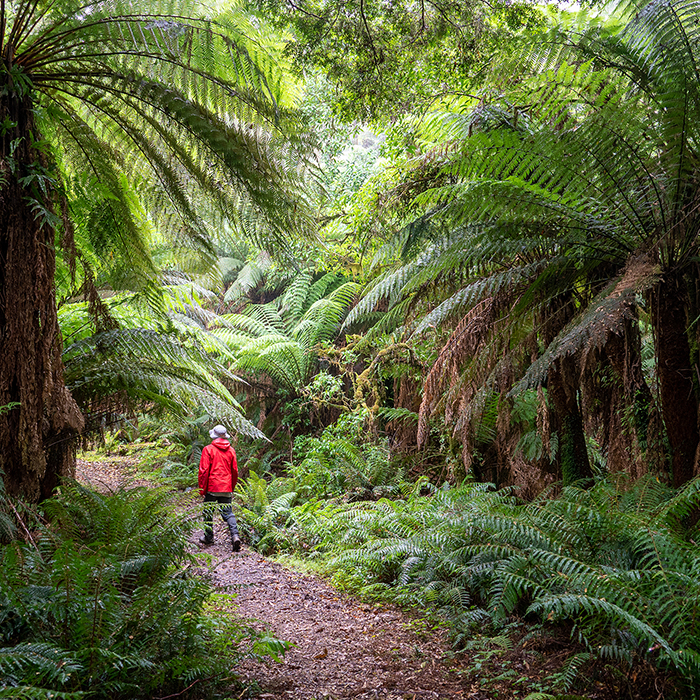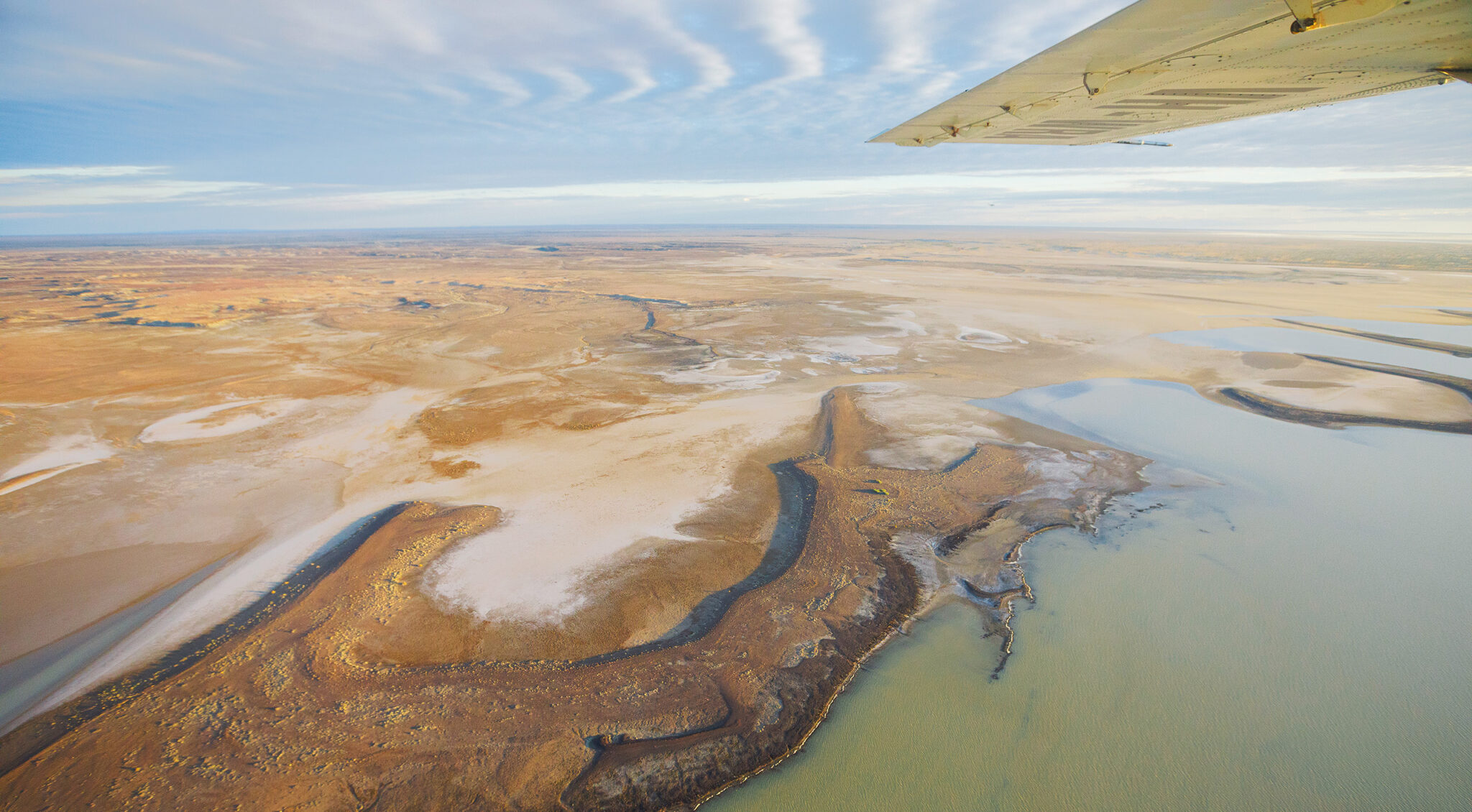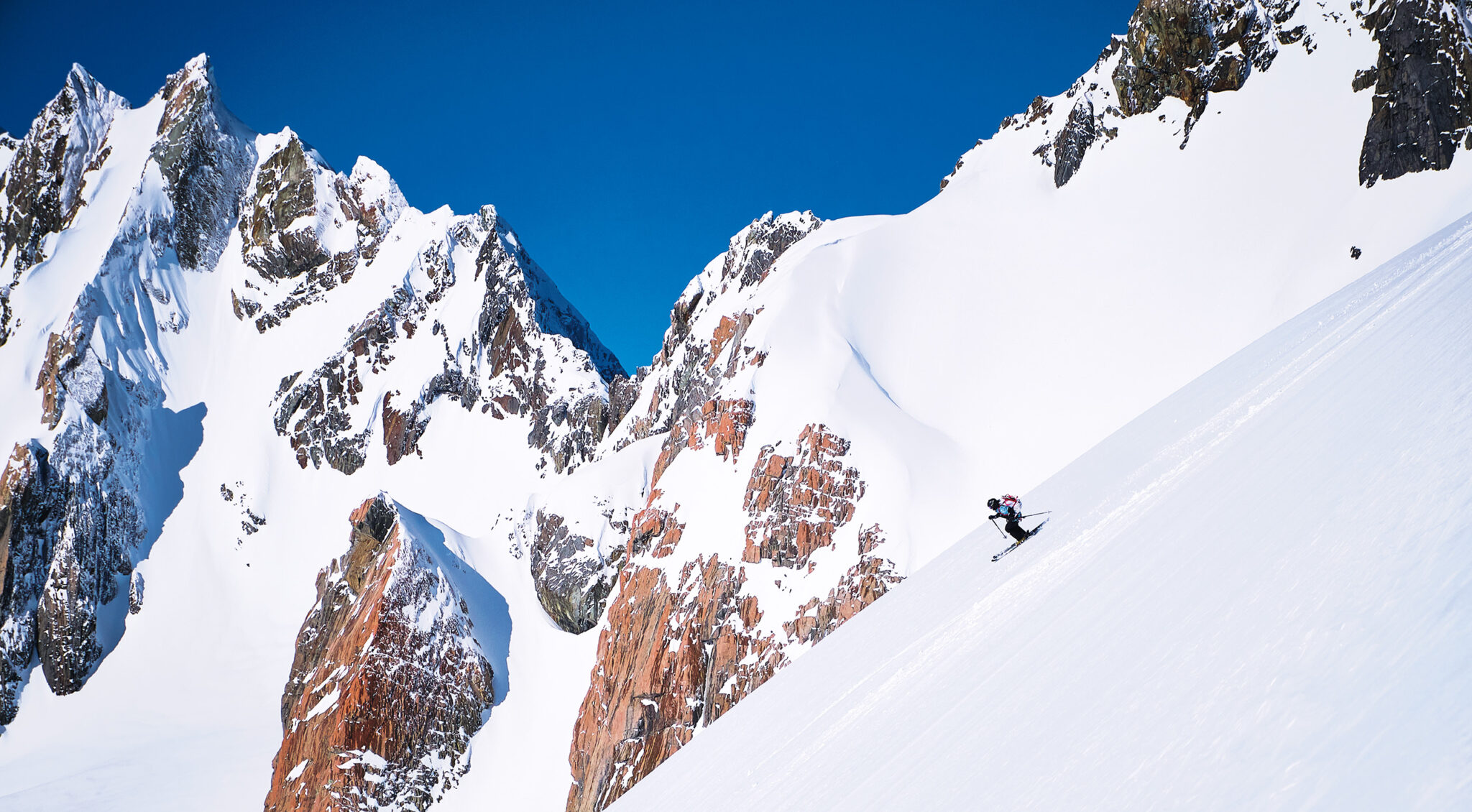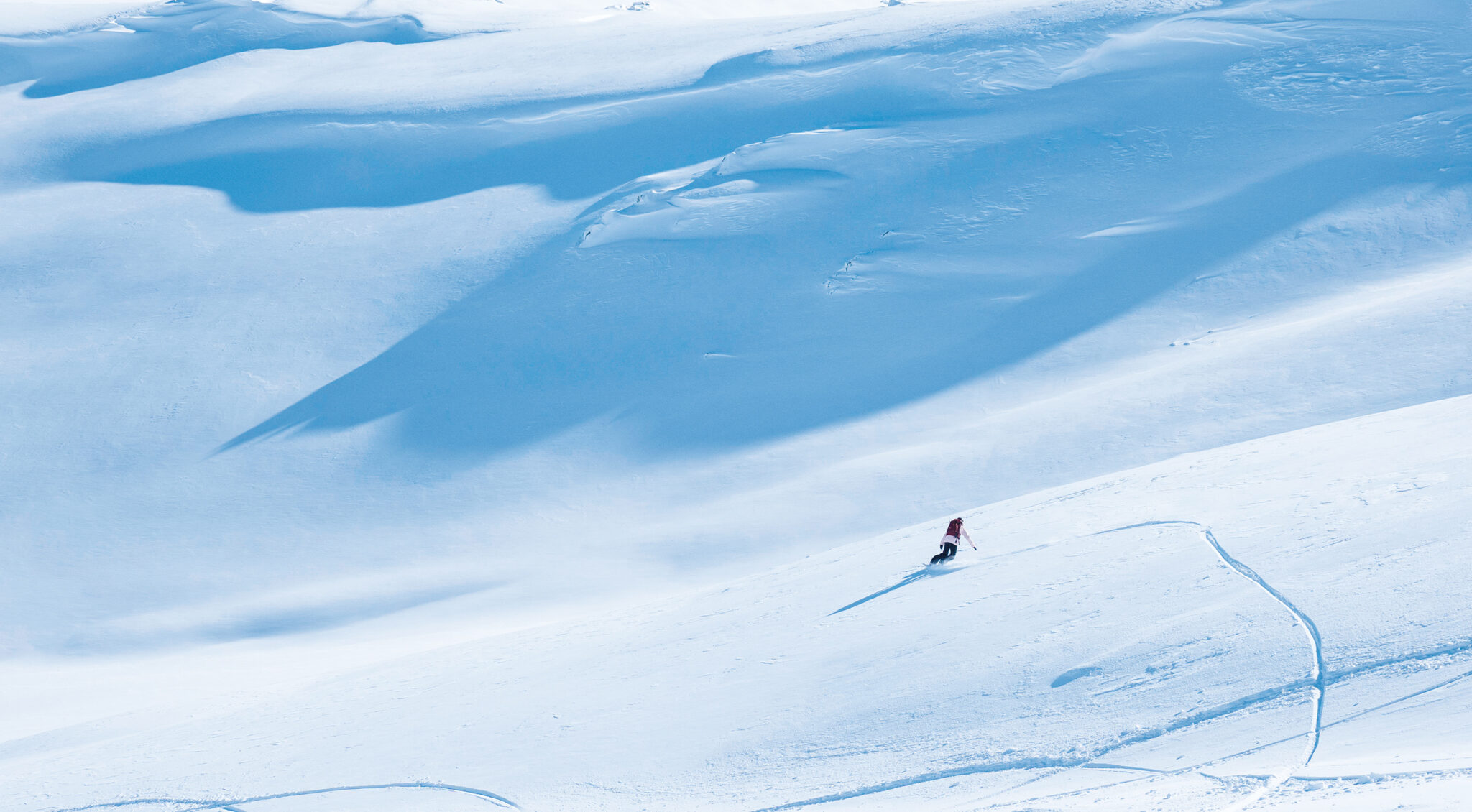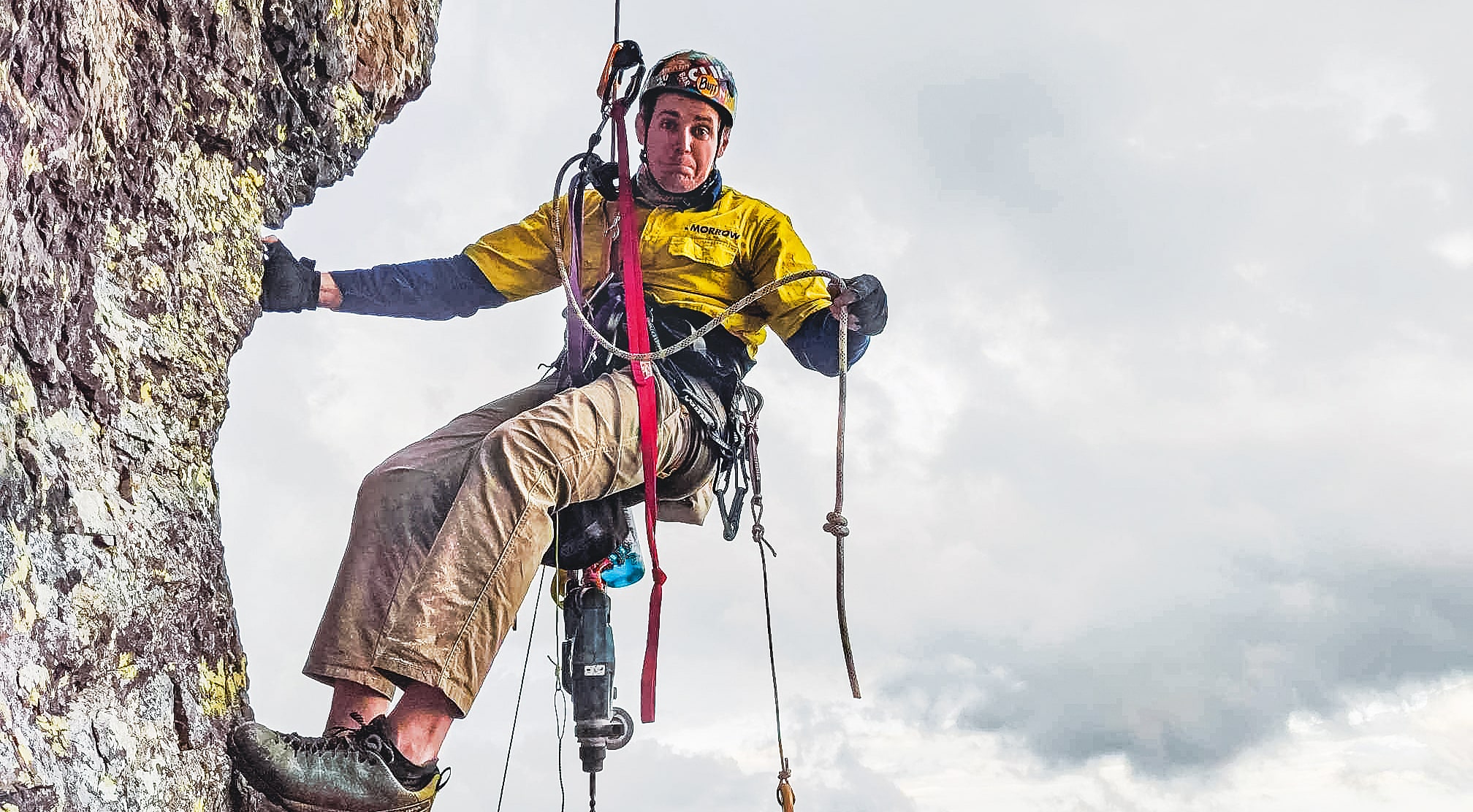The Grand Strzelecki Track
The Grand Strzelecki Track is a 93km collection of walking tracks, and fire and forestry trails, in the eastern end of the Strzelecki Range – all conjugated into a nature lover’s expeditionary artefact.
Words & Images: Craig Pearce
Subsea in rainforest wrack, Kurtz’s Conradian cry – “the horror, the horror” – choked air from my lungs. Track shattered. Light levels – this was midday – negligible. The nav subtleties necessary in this vegetal maelstrom made GPS and topo maps redundant.
But the life! Old growth blackwood, fern trees, fungi in Mardi Gras colours, lichens, moss on trees, rocks, moss on moss, in fact, and probably colonising me if I paused too long, a photosynthetic glory. I was captured, pinioned, transfixed by this jungle of rampant wild.
This tumult’s beauty, however, was of no help, brass tacks, in finding a way through it. Once were tracks were now nowhere to be seen. They had been weather-wrestled back into the no-track from which they were, no doubt with a great deal of grunt, cut. It took painstaking interrogation of terrain and its verdant population to secure progress. A game of loop detwisted loop.
This rampant, dynamic fracas I was ocean swimming through was Duffs Heritage Sawmill Trail, one of the Grand Strzelecki Track’s (GST) many green-teeming highlights.
The Big Hairy Audacious Goal
The Grand Strzelecki Track is a 93km collection of walking tracks, and fire and forestry trails, in the eastern end of the Strzelecki Range – all conjugated into a nature lover’s expeditionary artefact. Or, more accurately, into a Big Hairy Audacious Goal. A goal driven into existence, and coordinated by, an incorporated group of community volunteers.
Achieving The Big Hairy Audacious Goal – following a two-year build, it opened in 2012 – was one thing. Maintaining it is another thing entirely. In the high rainfall environment (there has been over 2,000mm per annum the past couple of years) of the Strzelecki Ranges where vegetation grows prolifically and the Southern Ocean often brings gales and even snowfalls, keeping the GST’s various arteries open is a massive logistical, funding and inherently political challenge. On my visit, treefall and track subsidence – and resulting track closure – were rife. About one third of the GST is in the Tarra-Bulga National Park, while the remainder passes through plantation and diverse native forests managed by Hancock Victorian Plantations (HVP).
Underlying the material aspect of keeping the track alive and open, is the equally demanding sophisticated stakeholder management required for this to occur. Unfortunately, what is a priority for GST’s community drivers, and those wanting to benefit from the myriad of experiences the GST offers, is clearly not the priority of the track’s two primary financial and logistical stakeholders, ParksVic and HVP.
That it is not HVP’s highest priority is understandable. HVP is a commercial entity, albeit one with a commitment to sustainability and community values. The company’s plantations are sustainably managed as a renewable, carbon positive resource. About 25% of original eucalypt plantation trees are retained, not harvested, to act as protective buffers and corridors for wildlife. HVP has also committed a significant amount of its land to conservation through the Land management Co-operative Agreement, signed with the Victorian Government. This agreement preserves forests on this land and their inherent biodiversity in perpetuity, regardless of future ownership.
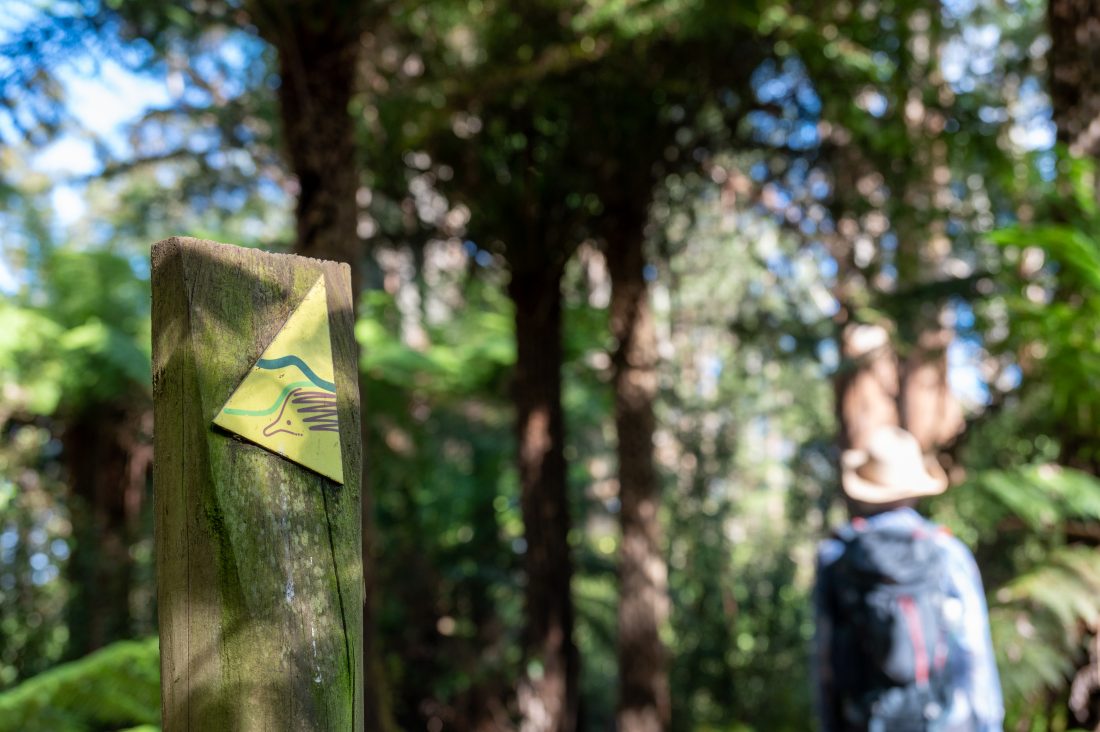
That it is not a higher priority for ParksVic, however, is more difficult to understand. For me, the primary issue could be solved by ParksVic being well funded enough to look after track maintenance in the HVP estate, as well as in Tarra-Bulga. They are experts in this sort of thing, after all. This would be a ‘public-private partnership’ offering much more meaningful – and environmental – value than the transport infrastructure they are commonly called into action for. But, clearly, ParksVic can’t even keep the majority of the tracks tended in the NP itself. Funding is surely at the heart of this. I am certain someone can find a logic for the millions of dollars directed towards the Grampians, Wilsons Prom and the Falls Creek-Hotham areas by the Victorian Government, and the comparative paucity evidently directed this way, but I’m not intelligent enough myself to figure it out.
In the Covid-struck year of 2020, 23,000 people walked at least some parts of the GST, and there were about 130,000 visitors to Tarra-Bulga NP. It’s about a two-hour drive from Australia’s second largest population centre. Corrigans Bridge and its adjoining micro-walks are frequently packed with day trippers. There is clearly a massive potential for the GST to be leveraged further by walkers and nature lovers (if the damn tracks were only open long enough for this to occur).
The track is comprised of three loops and one dog’s leg (itself made up of two sections, the 14km of Traralgon Creek and the 13km of Billys Creek, which connects Tarra-Bulga NP and Morwell NP). Both parks have suffered significant storm damage in recent times, and as a result the Billys Creek section is mostly closed.
Consideration is currently being given to either removing the full dog’s leg component, and/or remapping it into another loop. Weighing up the maintenance issues, however, and the value offered by the 66km of tracks and trails in the three loops, it appears to me the prudent approach would be to ‘limit’ the track to their riches.
The heart and soul of the GST are the cool temperate rainforest relics in the 2,000-plus hectares of Tarra-Bulga NP. The park is an emerald jewel, precious because of its beauty, ecological value and rainforest’s ever-diminishing existence on the planet. Spending time in it feels like a rebirth, due to the vigour and growth of life in such an environment. It can overwhelm, even intoxicate, you.
It will come as a surprise to no one that the fecundity of this eco-system has created a terrific degree of biodiversity. About 200 species of vascular plants including 41 species of ferns; about 290 different kinds of fungi and non-vascular plants such as mosses and liverworts; 115 vertebrate species; and a great deal more of bird and mammal species.
Rainforests of this sort contain examples of Antarctic flora that evolved on Gondwana during the Cretaceous period, more than 65 million years ago. One example is the dominant canopy tree, myrtle beech. Individual specimens may live up to 1,000 years old. Tarra-Bulga is actually a mix of rainforest and wet forest, part of what was once known as The Great Forest of South Gippsland, before most of it was cleared (timber-getting, pastoral, fires – normal white folks nature carnage).
Tarra-Bulga NP is a central part of the Gunaikurnai creation storyline where Borun the pelican travelled, carrying his canoe, from the mountains in the north to Tarra Warackel, on the coast south of the park, where he married Tuk the musk duck and, together, they founded the five Gunaikurnai clans.
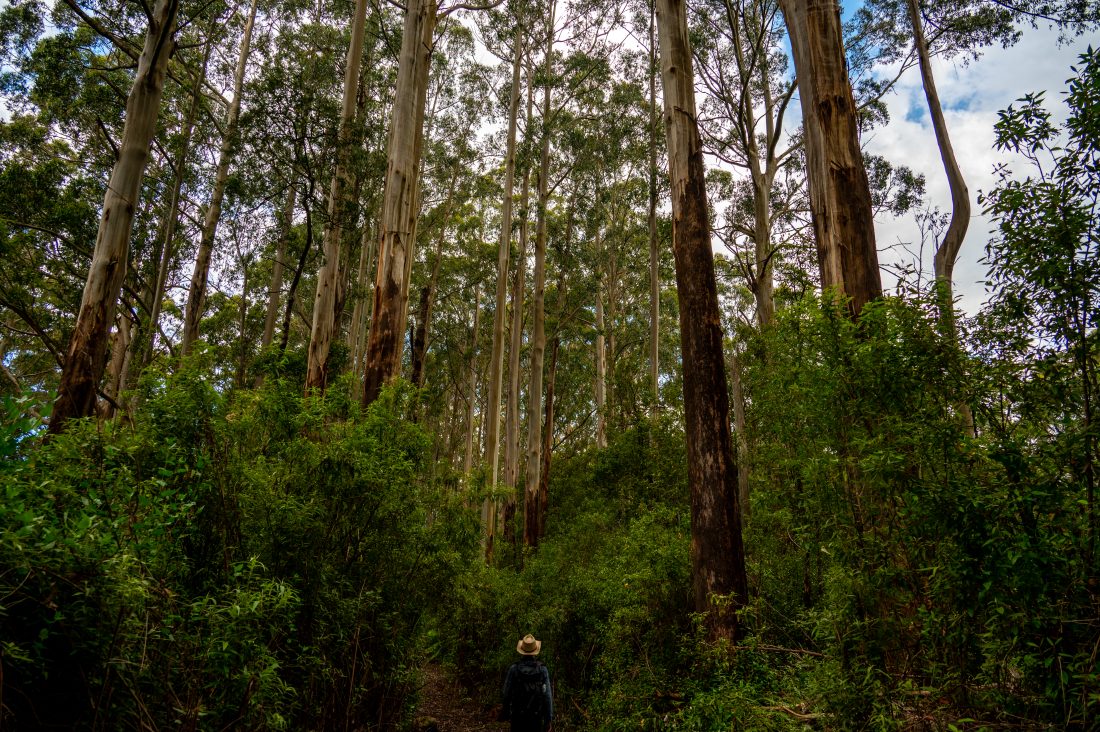
Loop du Valley
It was 37 degrees, baking, as I veered off the highway towards the Strzelecki Range, the hideous, massive, brown coal-burning Loy Yang Power Station an ominous sentinel. ‘No shooting’ signs. Rusting car hulks sunk on their haunches in parched grass. Deliverance? Into what? Timber plantation-cloaked hills followed. Nature experience it was feeling like, not.
But as the road serpentined its narrow way down from Mt Tassie into Tarra-Bulga National Park, things changed. Dramatically. The temperature dropped a good 15 degrees. The density, height and vivid greens of the cool temperate rainforest made their first, indelible impression. The dry, blasted heat of the plains morphed into an aqueous humidity. A wet blanket had been thrown over me.
The 23km Tarra Valley Loop was my ambition. It was a mid-afternoon/evening exertion, starting at a time when I’m often finishing up for the day. The logic being to avoid the heat. The humidity, though. Wow. Even with a light pack, I was sweating torrents not long after starting. I was cautious about snakes here in summer, so the long trousers and gaiters didn’t help with the heat. These prophylactics were also part of the strategy to ward off the other wrigglies rainforests are famous for – leeches.
The loop includes both thick rainforest and more open eucalyptus (plantation but not obviously so) segments. It was probably the most rollercoaster of the different GST sections, plenty of up and down but none of the elevation changes being significant. There was no shortage of slipping and sliding, some of this due to the off-track elements imposed on me because of treefall, but for the most part it was straightforward.
Highlights were many. Cyathea Falls are one of the park’s signature, must-see pieces of beauty. They are shrouded by dank rainforest and worth taking your time over. Diaper Track was up there with the best of the GST – small waterfalls, sky-tickling Mountain Ash and, like the Duffs Heritage Sawmill Trail, an all-pervasive sense of overwhelming immersion in rich, restless nature. I had the first of my many GST lyrebird encounters. There were plenty of swamp wallabies about (dusk clearly being the time to encounter them). And, my favourite and making me go all giddy for which grown man or not I make no apologies for thank you very much, a wobbly wombat accompanied me for a while, in glorious, unconcerned self-absorption.
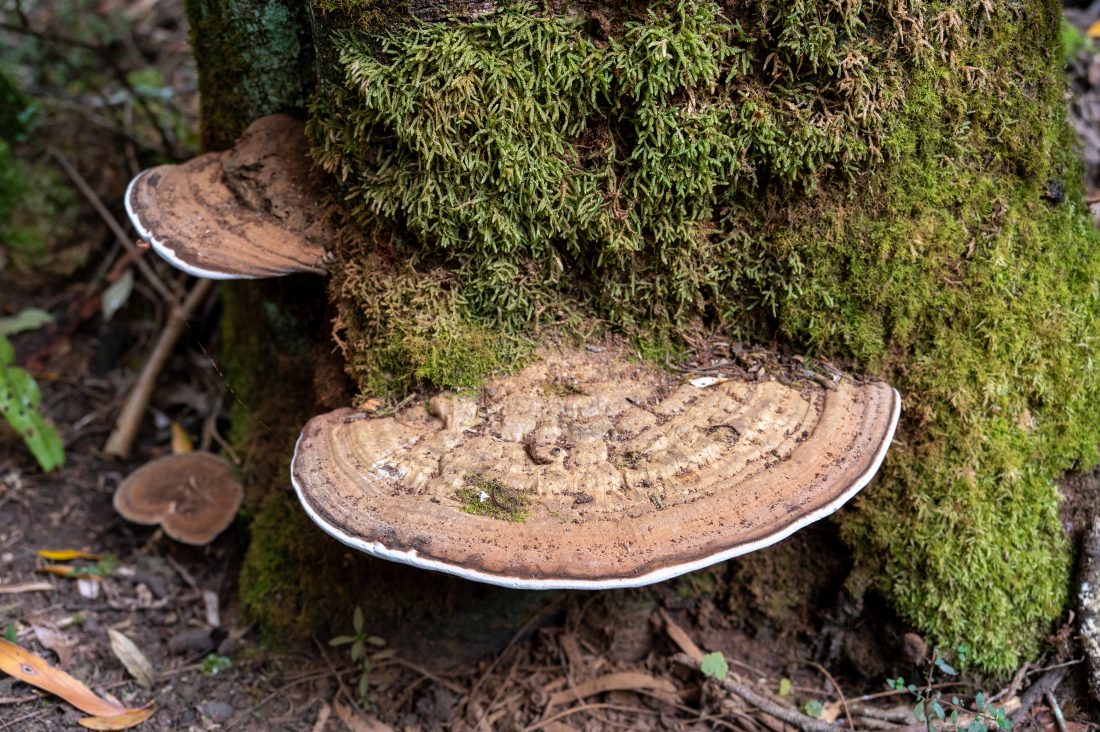
Loop du Mount
On my Mt Tassie Loop-designated day, I woke in a celestial glow. But the slow-strip-tent unzipping at dawn surprised me. A dense mantle of barely there mist – the faintest atomisation possible – enveloped the forest. Not raining. Just held in stasis, everything on pause (though not the eastern yellow robins bouncing around my campsite at Pattisons, on the periphery of the park. Their vivacity and song indicated they were just as joyous about waking as usual).
Counter-intuitively, the meteorological conditions enhanced the day’s walking. Not only did it help keep the temps down, which was a relief after the oppression of my Tarra Valley humidity-drenched day, but it embellished the scenery with a magical mystery ambience. I began and ended with the fairy tale tree fern enclave of Telecom Track, while that smashed fantastic of Duff Sawmill Heritage Trail (this segment being in the HVP estate) provided stark illustration of nature’s energy.
The most expansive views on the GST exist on this 18 km loop. As the West Face Track is climbed, passing some waterfalls, the crowded forest of Traralgon Creek gully opens up (the views were more constricted than a clear day would have provided, but the misty moodiness was irresistible). From Mt Tassie, the highest point in the Strzelecki Range, there were views over the plantation forest and distant farmland, a contrast to the closely quartered rainforest.
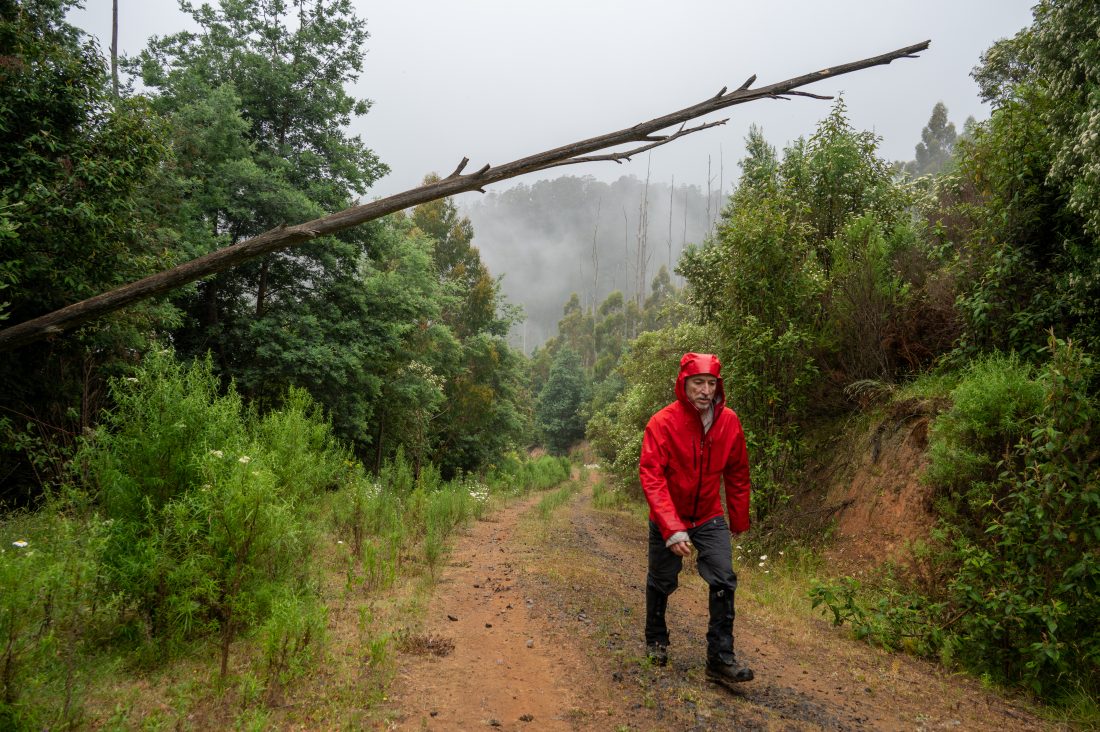
Loop du Jour
Investigating the GST’s three loops comprised a race, a wander and a hybrid explore, the latter being a combination of parts of the 25 km Macks Creek Loop and the necklace of short walks close to Tarra-Bulga’s visitor centre, including the signature traverse of Corrigans Bridge. The latter is quite the sight – a tree fern-packed gully, giant mountain ash rocketing out of its flanks and, of course, a gaggle of happy day trippers in selfie heaven.
Macks Creek Loop features both the cool temperate rainforest (dominated by myrtle beech) and warm temperate rainforest (dominated by sweet pittosporum). There’s also banksia and eucalypt forests to cruise through, though Olympic hurdling is closer to the mark on this loop’s Wild Cherry Track segment, so rife are the horizontal trees I was given no choice but to vault (or squirm under).
A large amount of the loop is through plantation, which has rainforest remnants in it. This loop – like all of the GST – offers a rich diversity. There are a number of creek crossings, with cascades aplenty, views eastwards towards the coast and a mountain grey gum thicket, with a wild and genetically intact koala resident population to keep your craning neck and powers of observation exercised. Flashes of yellow-tailed black cockatoos were lightening out of the trees and, while I didn’t see them, the eastern whipbird’s hard cracks echoed from the gullies. Crimson rosellas, too, throng the park in a kaleidoscope of colour.
If you’re starting this loop, like I did, from the visitor centre, you pass through the Lyrebird Ridge and Forest Tracks, components of that must-do necklace I mentioned. There are also the Ash, Fern Gully and Scenic Tracks, a braid around Corrigans, that, testing your head-tilting capacity again, will have you looking up at the world’s tallest flowering plant at over 100 metres, the mountain ash, as their upper reaches commune with the heavens.
While they were obviously there, I didn’t end up seeing any snakes. Other than, that is, a legion of bark snakes. Those strips of bark on the track that in a delirious walking fugue magically materialise into serpents dancing a deadly lunge in an unhealthily active imagination. Yep, saw lots of those.
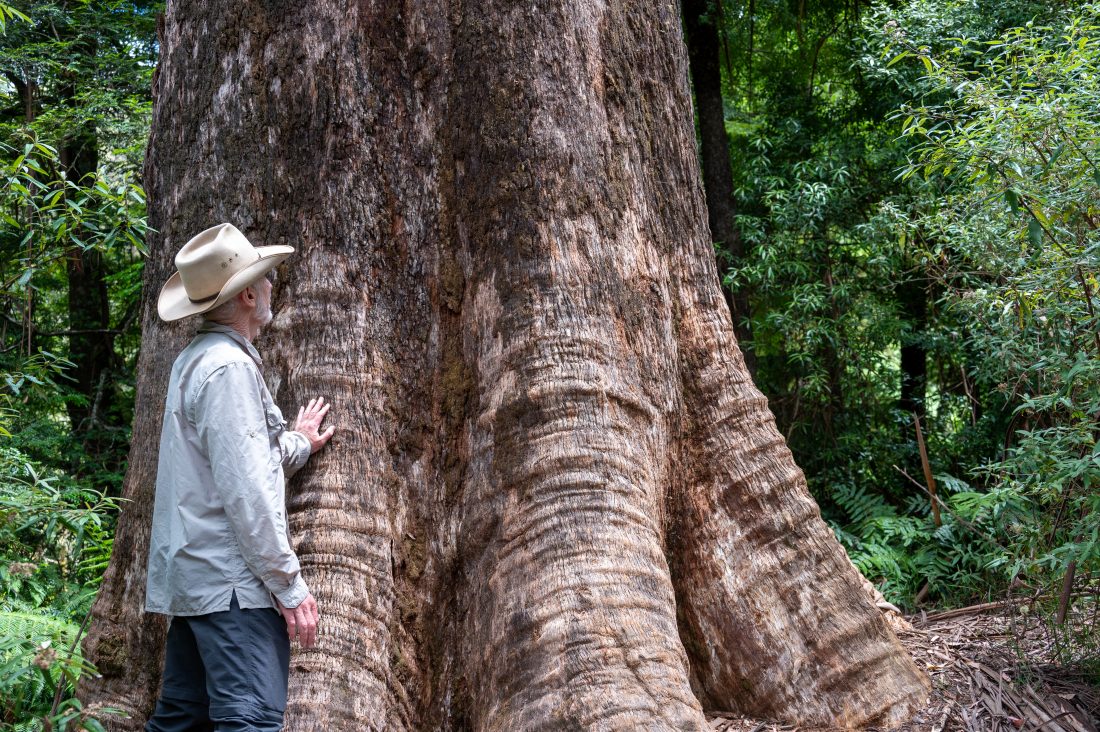
A leitmotif for the memory
The Grand Strzelecki Track – with its treefall, subsidence, deteriorated tracks, often barely readable interpretative signage, the madness of its vegetation and even a connecting bitumen road that is a shambles – felt like the land time forgot. In some ways, this is a good thing but, mostly, it’s not. The GST is an amazing ‘artefact’, yet large parts of it are off-limits to most because of its closed and/or deteriorated state.
It’s tempting to propose a fallen tree as the GST’s symbol, but it was its tree ferns I took away in my mind as its leitmotif. Their inevitably mossy trunks are danced over by lolling umbrella arms, which not only cast a green rinse to the air, but they drape over you, too, providing some protection from the inexorable rain that so profoundly shapes life in these parts.
Emphasising this, my final day here was spent sheltering from 60mm of La Nina-gifted rain. Vertical. Horizontal. Churning, washing machine gust-blustered. Not great for walking. But good for a mental and physical (and spiritual?) cleansing, and definitely hypnotising. I was taken back to the womb, swimming in an amniotic sea. A reminder of that distant Cretaceous period, of Gondwanaland, evolution’s steps; and the importance of this Country to nature’s balance, and to both its traditional owners and the thousands who visit this stunning palace of biodiversity.
Not forgotten, then, just not so important to the bureaucrats and politicians who control its destiny.
Wild and Craig Pearce acknowledge and respect Gunaikurnai people, traditional custodians of the Tarra-Bulga lands, and pay our respects to its elders past and present.

